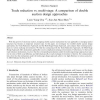Free Online Productivity Tools
i2Speak
i2Symbol
i2OCR
iTex2Img
iWeb2Print
iWeb2Shot
i2Type
iPdf2Split
iPdf2Merge
i2Bopomofo
i2Arabic
i2Style
i2Image
i2PDF
iLatex2Rtf
Sci2ools
87
Voted
EOR
2007
2007
Trade reduction vs. multi-stage: A comparison of double auction design approaches
With the growth of electronic markets, designing double auction mechanisms that are applicable to emerging market structures has become an important research topic. In this paper, we investigate two truthful double auction design approaches, the Trade Reduction Approach and the Multi-Stage Design Approach, and compare their resulting mechanisms in various exchange environments. We find that comparing with the Trade Reduction Approach, the Multi-Stage Design Approach offers mechanisms applicable to more complicated exchange environments. Furthermore, for the known trade reduction mechanisms, we prove that the corresponding mechanisms under the multi-stage design approach are superior in terms of both social efficiency and individual payoffs, in each exchange environment of interest. Our computational tests show that the mechanisms under the multi-stage design approach achieve very high efficiency in various scenarios. Ó 2006 Published by Elsevier B.V.
| Added | 13 Dec 2010 |
| Updated | 13 Dec 2010 |
| Type | Journal |
| Year | 2007 |
| Where | EOR |
| Authors | Leon Yang Chu, Zuo-Jun Max Shen |
Comments (0)

